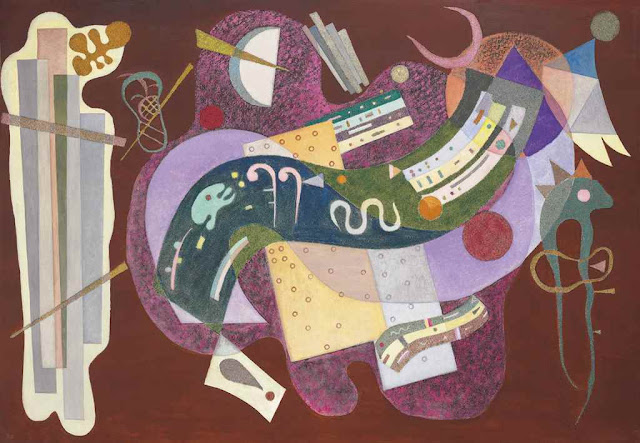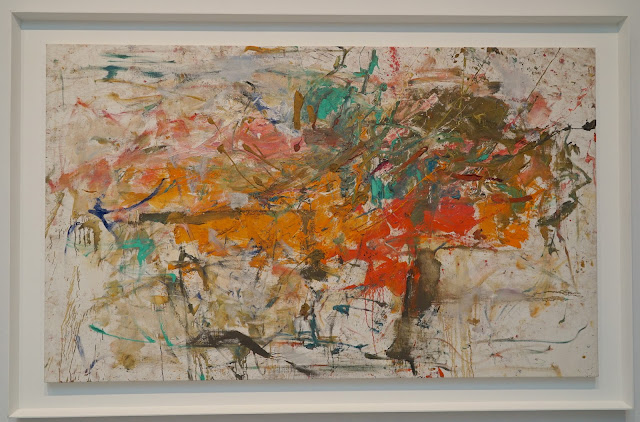One of the less known pleasures of being in New York is to go to look at the pre-auction exhibitions of Sotheby's and Christie's. What you see is an astonishing variety of art, some of it extraordinary, and a fair amount of it routine. But the end result is a show which would be the envy of any provincial museum. And the exhibitions are not curated in any thematic way. What you see is what people want to sell. Some viewers may miss the idea of a curatorial voice in what we see on the walls. While I often appreciate a well curated exhibition, it doesn't bother me to not have that voice. I am happy to look at art. (There is a quite a bit of debate these days in art criticism about the role of the institutional apparatus of museums in shaping how we understand art. In this case, there is no question about the role of the institution. It wants very rich people to buy the art.) I went to the viewings at Christie's at Rockefeller Center. There were wonderful things to see, especially a Paris-period Kandinsky that had very interesting textural details that wouldn't show up in any normal reproductions. The paint was mixed with sand in some cases. Christie's created a mini catalog just for this painting. A Monet haystack painting, a great DeKooning, Picasso, Cezanne, etc. as well as Helen Frankenthaler, and many big names from the contemporary art world. There was a large Gerhard Richter painting advertised as belonging to the collection of Eric Clapton, estimated to sell for 25 million dollars. With CD sales tanking, maybe he needs the money....
I also did a gallery day in Chelsea to see some of the new big name exhibits, both in photography and painting. While in general photography is not a big thing on the contemporary art world, there are a few photographers that have somehow transcended the photography world and entered in to the contemporary art world, with its corresponding stratospheric prices. Hiroshi Sugimoto is one example. Andreas Gursky is a another. He made his name with fascinating very large size photographs like this one:
There was a new show of his work at the Gagosian Gallery, with works like this one of an Amazon warehouse (It's about 12 feet long); every detail of the merchandise is crystal clear. It's not clear, however, the extent to which it has been assembled and composed in Photoshop or something like that.
He has been drifting towards more conceptually oriented work in the last few years, but some of the newer work connects more directly to his earlier work. Part of the point of these works to me is their sheer monumentality. They are really big! We don't normally think of photographs as things of this size. Part of me enjoys this massive quality, while another part of me gets annoyed by it; these are clearly showpiece type of works, meant to impress, and created for museums and for people with huge white wall spaces.
One of my favorite photographers is William Eggleston, who creates beautifully composed color images out of the mundane world of American daily life, particularly in the South. The David Zwirner Gallery had a show of images newly printed from his classic series from the 1980's, "The Democratic Forest". I was very surprised when I arrived at the show to see very large size photographs (about 3 feet by 4 feet). All the Egglestons I have seen before were much smaller. These were in fact new prints from older negatives, and perhaps made larger than before to help compete in the "bigness" category as exemplified by the Gursky photos. In addition, Eggleston's original prints of the time were made with something called the dye transfer process, which enables an extraordinary vividness of color. These new prints are pigment prints, and do not have that vividness, to my eyes. An, in addition, the large size prints basically look too blown up; I prefer the standard size. But I still love the photos, and anyone who has looked at my photos on this blog will see that affinity.
A few examples:
Another photographer on my itinerary was the Canadian Edward Burtynsky. Burtynsky has always caught my eye with his dramatic large-scale photographs of degradations of our environment, usually taken from a great height. I have always found myself drawn to his work in photography books, but I found myself questioning the whole enterprise when I saw the works in their normal large scale format (about 5 to 6 feet wide). They became too pretentious. And, as well, there is something perverse about finding beauty in, say the different colored pools of the polluted residue of mining operations.
One of the fun parts of doing the galleries is coming across work you have never heard of or seen before. I wandered into a gallery showing the work of Sandi Haber Fitfield. She does an interesting combination of photography and drawing. She uses manipulated photos, often of line centered things from nature, and then draws in both graphite and color around them. Although the idea seems simple, it somehow in my eyes does something that is different from other photography or drawing.
Finally, after all these photographs, there were paintings. First of all, a small show of the work of one of my favorites, Joan Mitchell.
(I was at the Metropolitan Museum a few days later, and I was immediately struck by this Monet, which looked very much like some of Mitchell's work.)
And, finally, a show of Mark Rothko paintings entitled "Dark Palette" focusing on paintings of his that used very dark colors. It was an intense experience to see these several rooms of very dark paintings. They reveal themselves slowly. Some were really, really dark. It was particularly interesting to see one of the paintings commissioned for the Four Seasons restaurant (and never used). You can't really photograph Rothko, but this Four Season painting had a very unusual shape for a Rothko.
Amazing to think that I saw all of the work in this post without stepping into a museum!















